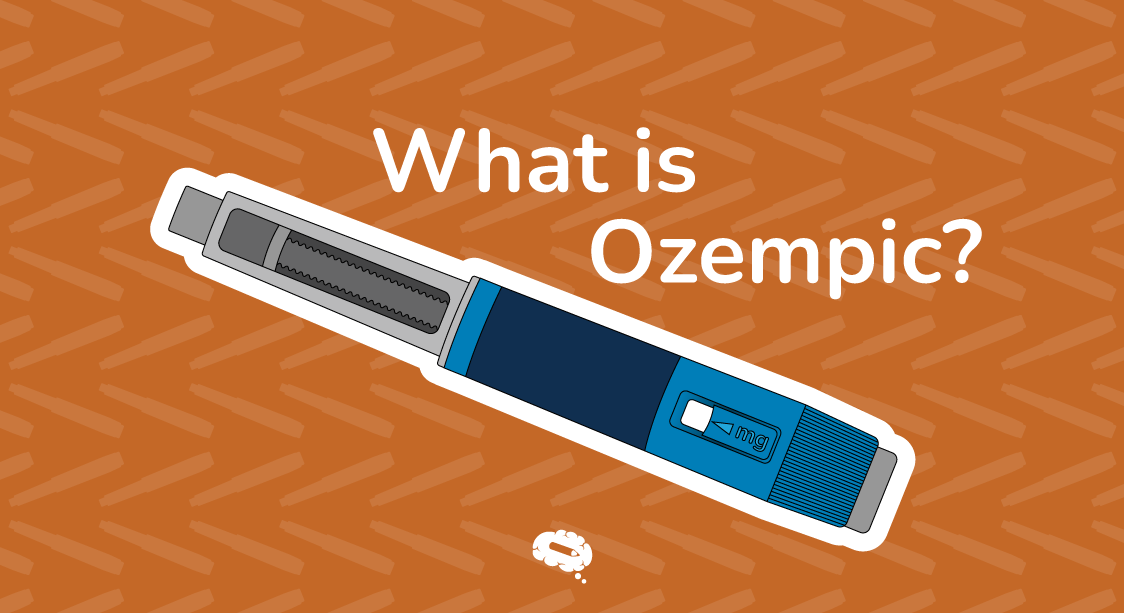When did you hear someone asking, “What is Ozempic?” for the last time? What about getting information about it to fulfill yours and someone else’s curiosity? Ozempic is a relatively new drug that has been making waves in the field of diabetes treatment since December 2017. Studies sponsored by Novo Nordisk, the company behind the medication, suggest adults with type 2 diabetes who take semaglutide — the active compound in Ozempic — may lose weight.
In this article, you can learn about what is Ozempic and its benefits, understand the relationship between this drug and weight loss, and discover its side effects on adults not diagnosed with the disease.
What is Ozempic and why is it attracting so much attention?
Ozempic is an injectable medication prescribed to adults with type 2 diabetes to help improve blood sugar in and to lower hemoglobin A1C, a measure of blood glucose over time. Furthermore, it aids in lowering significant adverse coronary events like heart attacks and strokes.
One of Ozempic’s main advantages is its once-weekly injection schedule, which is a vast improvement over the daily injections needed with many other diabetic treatments. Patients who are already coping with a lot of stress and complexity in their lives may find this to be quite helpful.
A growing number of celebrities, including Khloe Kardashian, Kyle Richards, Chelsea Handler, Jameela Jamil, Elon Musk, and Remi Bader, have either confirmed – or been rumored – to have used the drug for weight loss.
The hashtag “Ozempic,” with over 450 million mentions on TikTok, reveals individuals who alternately express amazement about their alleged medication-induced weight loss and astonishment about its side effects.
How does Ozempic work?
Ozempic mimics a hormone called glucagon-like peptide-1 that is naturally produced in the intestines and reduces appetite by letting our bodies know when we are satisfied, causing our stomachs to empty more slowly, and prompting the pancreas to release insulin when it is required.
By stopping the liver from producing and releasing too much sugar and assisting the pancreas in producing more insulin when blood sugar levels are high, the drug helps to lower blood sugar levels and A1C.
Who is supposed to take Ozempic?
1. Those with type 2 diabetes who have been unsuccessful in managing their blood sugar levels alone with diet and exercise are administered Ozempic.
2. Those who struggle to control their blood sugar levels while taking other diabetes treatments may also benefit from it.
Who should avoid it?
Before recommending a prescription, medical professionals will take into account the patient’s age, medical history, and any other medications they may be taking.
Patients with type 1 diabetes and diabetic ketoacidosis, generally known as DKA, should avoid the medication. This risky disease develops when your body has an abundance of acidic compounds known as ketones.
Patients with the following conditions should avoid Ozempic:
- Pancreatitis
- Type 1 diabetes
- Under 18 years of age
- Pregnant or breastfeeding
- Diabetic retinopathy
- Problems with the pancreas or kidneys
- Family history of medullary thyroid carcinoma (MTC)
- Multiple Endocrine Neoplasia syndrome type 2 (MEN 2), an endocrine system condition
Be aware of the side effects
Because of its negative effects, Ozempic carries a boxed warning from the Food and Drug Administration (FDA), claiming that the medicine can lead to thyroid cancer and tumors in animals.
Common side effects include low blood sugar, upset stomach, heartburn, burping, gas, bloating, nausea, vomiting, loss of appetite, diarrhea, constipation, runny nose or sore throat, stomach flu symptoms, headache, and dizziness.
More severe side effects can include diabetic retinopathy, gallbladder disease or gallstones, cholecystitis, which is gallbladder pain and swelling.
Other side effects may include:
- nervousness
- nightmares
- pain in the stomach, side, or abdomen, possibly radiating to the back
- seizures
- skin rash
- slurred speech
- tightness in the chest
- trouble breathing
- unusual tiredness or weakness
- yellow eyes or skin
It is crucial to remember that Wegovy is not appropriate for everyone and should only be taken with a doctor’s supervision.
Visually appealing figures for your research
Mind the Graph is a powerful online tool for scientists who need to create high-quality scientific graphics and illustrations.
The platform is user-friendly and accessible to scientists with varying levels of technical expertise, making it an ideal solution for researchers who need to create graphics for their publications, presentations, and other scientific communication materials.
Whether you are a researcher in the life sciences, physical sciences, or engineering, Mind the Graph offers a wide range of resources to help you communicate your research findings in a clear and visually compelling way.


Subscribe to our newsletter
Exclusive high quality content about effective visual
communication in science.





